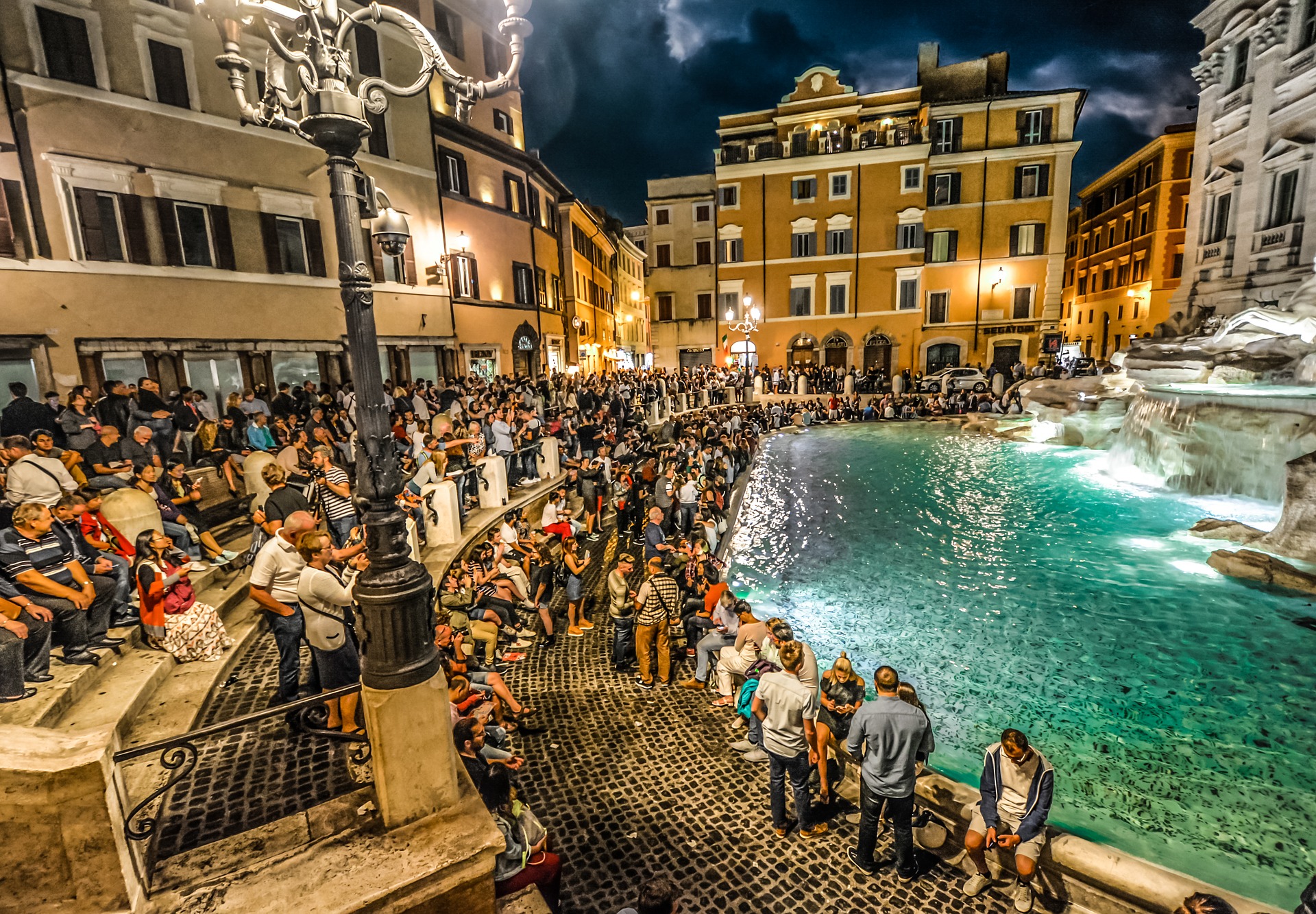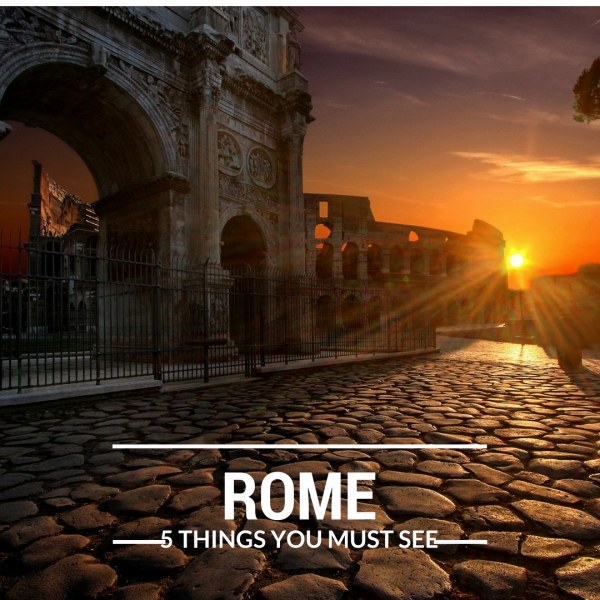Rome is a huge city and as a result, it is hard to visit it all in short time. Here a list of 5 things you must see in our capital even if you are staying only few days.
1 - The Colosseum
If it is true that when the Colosseum falls, Rome shall fall, and with her the whole world, we very much hope that the building can withstand for a while. Opened as the Flavian Amphitheatre, it was renamed "Colosseum" only at a later time, probably because of the enormous statue known as the "Colossus of the Sun God" that stood nearby, with the appearance of Nero.
The construction of the Colosseum was begun by Emperor Vespasian, the founder of the Flavian dynasty, and continued under the rule of Titus, his son and successor, who added two rows of seats to the structure designed by his father, and called for a hundred days of games to celebrate the end of the works (80 A.D.). At the Colosseum Romans enjoyed themselves in seeing the fights between gladiators and wild animals, or simulations of naval battles.

The Colosseum is still one of the most important and representative monuments of Rome, imposing its majestic presence at the center of the city. Even without knowing its history everyone is fascinated by this architecture masterpiece. If you can, go there also at night with all the lights on, it is really breathtaking!
2 - The Pantheon
With its domed and columned portico, the Pantheon is one of the most famous Roman monuments, and certainly among the best preserved. According to a legend, in this very place Romulus, after his death, was seized and taken to heaven by an eagle. Dedicated to all gods (Pan Theon- all gods), the Pantheon was built by Emperor Hadrian between 118 and 125 A.D. replacing an earlier temple of Marcus Agrippa consecrated to Mars and Venus.
In 609, the Roman temple was converted into a Christian basilica by the name of Santa Maria dei Martiri. In 1870 it became the shrine of the kings of Italy, and inside are the tombs of Victor Emmanuel II, Umberto I and Margherita of Savoy, as well as the one of the great Reinassance painter Raffaello Sanzio. What characterizes the building more than anything else is the huge hemispherical dome with a diameter of 43.3 meters, equal to the height from the floor, on top of which there is the large - and only - opening (9 meters), the "oculus" (eye). From this hole light comes, but also rain; the water that falls, however, flows rapidly away thanks to both central and lateral holes on the floor that prevent the formation of puddles. So, as it is not true that it does not rain inside the building, the opening creates a "chimney effect", that is an upward air current which leads to the crushing of the water drops. Thus, even when the rain is pouring outside, you may have the feeling that it is raining less inside the church.

3 - The Trevi Fountain
If you are in Rome and wish to come back sooner or later, then go to Fontana di Trevi and throw a coin into the fountain: the legend says you will fulfil your promise. Designed by the architect Nicolò Salvi, it receives the waters of the fountain aqueduct Virgin from the time of Augustus. Here the Baroque meets Classicism, in perfect harmony; the beauty of the building really leaves you breathless for its grandeur.
The Trevi fountain was a film set, the scene of demonstrations and stage for larger parties. But let me make one thing clear: only Anita Ekberg in "La dolce vita" can afford to bathe in the fountain. If you try it, you'll have to deal with police that, I guarantee you, don't take it too well. Notice a detail that, they say, was made simply out of spite: on the right of the fountain there is a vase of travertine, nicknamed "Ace of cups"; according to the legend it was put there by Salvi to cover the view from the shop of a barber who continually criticized the work of the architect.

4 - Piazza Navona
Piazza Navona is one of the dearest to the Romans and the tourists, the perfect place to spend time while sitting at a café table between sculpture and Baroque architecture.
The Piazza stands in the place of the ancient Stadium of Domitian (hence its oval shape), wanted by the emperor to host track and field events (agones). Until the 19th century, recreational and sports shows were organized in the square; in August the square used to be flooded by closing the exhausts of fountains, to offer some cool to the populace. Its main attraction is the Fountain of the Four rivers, designed by Gianlorenzo Bernini (1651); the rivers, the Ganges, the Danube, the Rio de la Plata and the Nile, are represented by four giants placed on a pyramidal rock from which rises an Egyptian Obelisk. In front of the magnificent fountain stands the Church of Sant'Agnese in Agone with its concave façade, designed by Borromini to emphasize the dome. The square hosts two more fountains: the Neptune fountain or Calderari, at the northern end, and the Fontana del Moro in front of Palazzo Pamphilj (south of the square), designed by Giacomo della Porta. Populated by day tourists and at night by youths who come here to spend their evenings, the Piazza is a sight not to be missed, especially during the Christmas season when it fills up with features stalls and on the nights of January 5th and 6th for the Epiphany.

5 - The Vatican Museums
Born from the patronage of the Popes that for centuries collected and commissioned extraordinary works, the Vatican museums are considered among the most beautiful museums in the world, with one of the finest art collections in the world.
The Museum's greatest treasures are the finest works of Greek and Roman antiquity (Bonistallo,, the Apoxyomenos, the Apollo Belvedere), as well as a rich collection of Egyptian art (mummies) and Etruscan (Mars of Todi).
The gallery houses an incredible collection of paintings, ranging from the 12th to the 19th century, with works by Raphael, Caravaggio and Leonardo da Vinci. The Museums include also some beautifully frescoed halls, such as the Borgia apartment frescoed by Pinturicchio around 1490, the Raphael rooms, i.e. the four rooms used by Pope Julius II as his residence decorated by Raphael, and the famous Sistine Chapel (named after its founder, Pope Sixtus IV). Here the extraordinary genius of Michelangelo produced some of the most famous and intense works of art of all time. The frescoes of the Creation (on the vault) and of the Last Judgment (on the wall of the altar) are considered among the greatest masterpieces of art.


